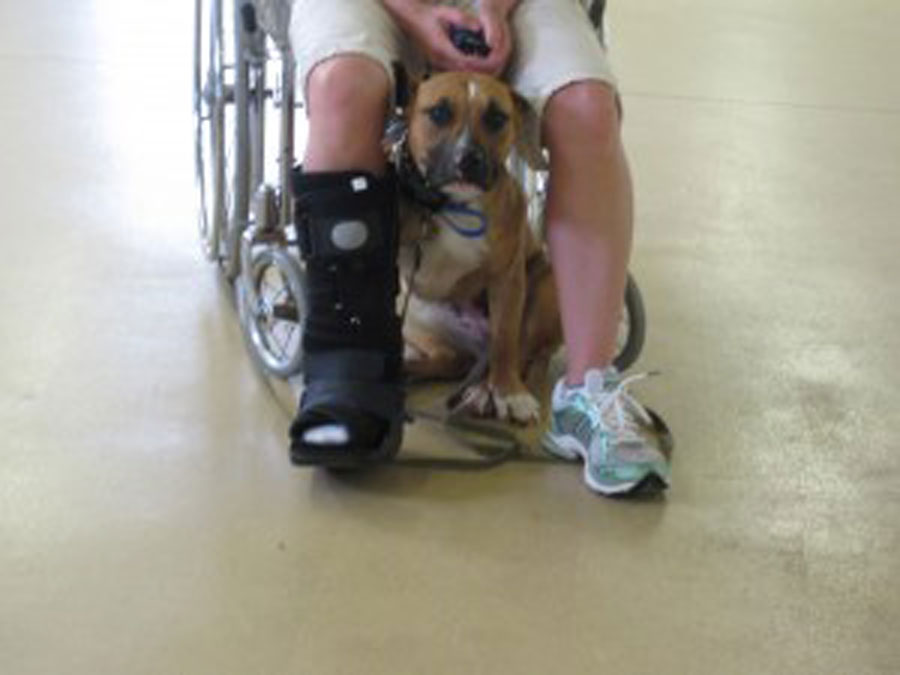Nora – The pitbull mix in training at That’s My Dog!

Does that picture evoke a few emotions? Probably, I expect it would. Not the happiest photo. But wait till you see some of the others that are to come.
This is Nora (and me with the soft cast). Nora is the dog we are fostering for training here at That’s My Dog!. If you’re not familiar with her story you can check out this previous blog entry.
Today she ran with a pack of seven other dogs with no problems at all. Her communication skills with the other dogs were awesome. The theory about Nora was that she had been used as bait for dog fighting so I think most would of expected her reaction to be quite different around all those dogs.
We hear many stories on how someone rescued or adopted a dog from the shelter and how they believe the dog “must have been abused” because he/she cowers around men, or runs away from a broom or growls at children. The list of reasons is long and the ideas speculated are numerous. But what I want to remind everyone of when they do this is IT IS ONLY SPECULATION. We don’t really know and unfortunately the dog’s can’t tell us. As a matter of fact, I believe more often than not, most dogs coming from the shelters simply have not been exposed to new situations and thus their reactions of fear and hesitation. They have probably led a life of too much solitude, at times neglect, which isn’t great for the dog either, but I truly don’t think most people who drop their dogs at the shelter have physically abused them.
As much as we wish the dogs could talk and explain what is going through their head when they cower, or growl, or flee…..we are always just guessing. And too much valuable rehabilitation time can be spent getting caught up in the *what ifs*. I think the really important thing is to deal with the triggers and teach the dog a behavior that is more appropriate. In my opinion, let’s get on with the work and give the dog a really great new life!
To some I think that may sound cold hearted, but seriously, what good does pity do? It is important to realize how much power the words *rescue* or *adopt* often have on our attitude toward the dog. We need to recognize the situation a dog came from but I caution people from getting so wrapped up in pity for that past situation that they allow it to become a barrier to helping the dog move forward. It is not unusual to see people using those words as the excuses as to why their dog continues to behave in inappropriate ways.Do we have sympathy for a dog’s state of mind and what they have *possibly* been through? Yes, of course we feel bad when they display such sad behaviors. Allowing these emotions to get in the way of truly helping the dog get better is something I won’t do, don’t let my staff get caught up in and want to help you understand how important this is for your own dog as well.
Let’s think of it for a moment in human terms. If you were to adopt a 2 year old child who had been abandoned, raise them and when they go off to kindergarten the teacher calls you in and says Little Jimmy is picking fights with the other children. Is your first response “well he’s adopted?, we think he was abused before we got him” Seems kind of silly doesn’t it? And can you see how it becomes a crutch to fixing the problem?
That is my point in the language and the speculation we are using when we talk about rescue dogs in general. It evokes too many ideas and images of something that is broken and I think often puts us in the mindset of it “can’t be fixed” so we will just avoid all those situations or perhaps worse yet, “the poor thing, let’s comfort him”. For you see, comforting a dog in the form of cooing and stroking reinforces the very behavior they are displaying at the moment. Yep, that is correct, when the dog is growling at a little kid cause we “think he was taunted and abused by children before we got him” and then we reach down, stroke the dog and say “It’s okay Fido, you’re okay, they won’t hurt you” the dog’s interpretation is ” My owners are happy when I growl at little kids” AND They pet me for it!! Any intelligent dog is going to keep doing behavior that they believe their owner wants. So you have to look in the mirror to discover who really is the problem behind the dogs behavior. It is time to change.
So let’s stop here and decide sympathy for the dog can be felt but not displayed. We are now going to assume the role of physical therapist as we embark on the adventure of dog rehabilitation. I can tell you from personal experience had it not been for some fantastic therapists who pushed me to rehab from an automobile accident that left me in a wheel chair I would not be walking easily today. That accident still sets me back from time to time, but you learn to let it go and move past it and so can your dog.
Yea Nora!! Today you smiled and ran and it was a lovely thing!

